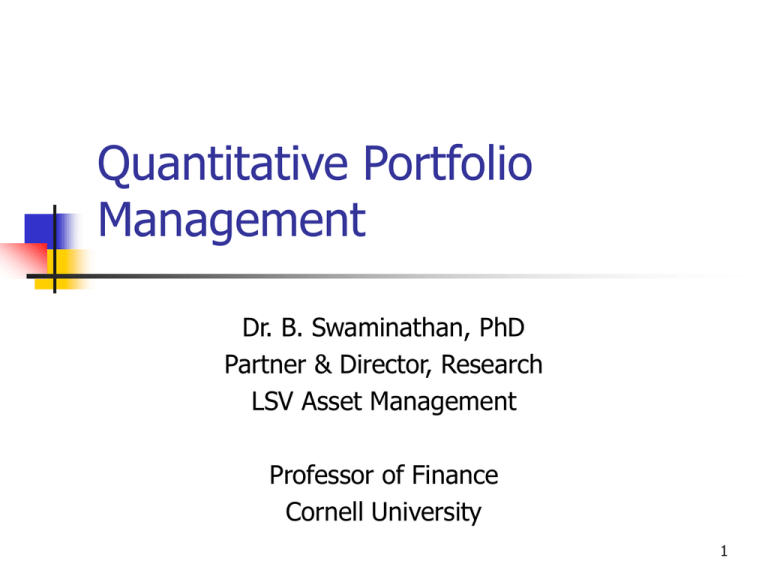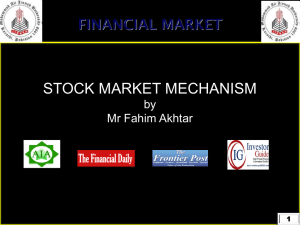Quantitative Portfolio Management
advertisement

Quantitative Portfolio
Management
Dr. B. Swaminathan, PhD
Partner & Director, Research
LSV Asset Management
Professor of Finance
Cornell University
1
LSV Asset Management
LSV in business for 12 years
More than $75 billion under management
Academic foundation
Deep value equity orientation; stock selection
based on proprietary quantitative models
Domestic / International
Well diversified / risk controlled
Active money manager, not a hedge fund!
Objective: to beat the market!
2
U.S. Markets: Value vs. Growth
in the last 2 years
3
LSV past performance
Periods Ended September 30, 2007
U.S. Active Strategies
YTD
1 Year
Since
5 Years 10 Years Inception
LSV Large Cap Value (12/1/93)
Russell 1000 Value
S&P 500
6.5%
6.0%
9.1%
15.3%
14.5%
16.5%
20.7%
18.1%
15.5%
11.6%
8.8%
6.6%
Non-U.S. Active Strategies
YTD
1 Year
5 Years
LSV International Value (1/1/98)
MSCI EAFE Index (net)
MSCI EAFE Value Index (net)
12.1%
13.2%
9.6%
25.1%
24.9%
22.0%
28.0%
23.6%
25.7%
MSCI: Morgan Stanley Capital International
EAFE: Europe, Australia, and Far East Index
$AUM
$28.2 B
Closed
7 Years
15.8%
12.4%
11.0%
Since
Inception
18.0%
8.2%
10.8%
16.0%
9.1%
11.3%
$27.3 B
Closed
$AUM
4
How does LSV construct its
portfolios?
Using mean-variance portfolio optimization theory:
Min
{w1 , w2 ,, wN }
N
: σ 2p
wi 1
i 1
N
subject to,
(1a)
(wealth constraint)
(1b)
wi E (ri ) E rP (expected return constraint) (1c)
i 1
p2 is the portfolio variance which is a function of
individual stock variances and covariances
E(rp) is the expected return required from the portfolio
wi is the fraction of wealth invested in each security
E(ri) is the return expected to be earned in each security
5
Inputs to the problem
Start with a list of stocks (say the most “attractive” 100 stocks
in the U.S. stock market).
Input the return each stock is expected to earn over the next
year. You will have a column of 100 expected returns.
Estimate each stock’s variance and covariances with every other
stock. You will have a 100100 variance-covariance matrix.
Add additional constraints as necessary (industry constraints,
short-selling constraints, socially responsible investing
constraints).
Construct a portfolio with the highest expected return for a
given level of risk.
6
Our expertise is estimating expected
returns
Our investment philosophy is based on behavioral
finance: Stock prices can deviate from intrinsic/fundamental
value because of the actions of naïve (unsophisticated) investors
who trade based on emotion/psychology as opposed to
fundamentals:
Extrapolation bias
Overconfidence bias
We believe such mispricing/inefficiencies can be identified
through careful empirical research involving historical stock
market data and exploited to earn above average returns.
Our quantitative model is built to identify securities that are
undervalued (price less than intrinsic value) and expected to
earn above average returns over the next 2 to 3 years.
7
Market efficiency and behavioral
finance: A digression
Market efficiency Price = Intrinsic Value
Questions:
Are the markets efficient? (Are the prices right?)
Can we beat the market? (Is there free lunch?)
If the prices are right can we earn free lunch?
Does “no free lunch” imply prices are right?
8
Apparent violations of market
efficiency
Reversals at short horizons (day, week,
month): buy loser, sell winner.
Momentum at intermediate horizons ( 3
to 12 months): buy winner, sell loser.
Reversals again (value/glamour) at long
horizons (3 to 5 years): buy loser, sell
winner.
9
Rational paradigm
Rational beliefs:
Update beliefs using Bayes theorem.
Rational preferences: Maximize
expected utility where:
people prefer more to less
diminishing marginal utility of wealth (as
you get wealthier an extra $1 of wealth
brings a smaller increase in utility).
10
What is behavioral finance?
Behavioral finance attempts to understand the
evolution of security prices and explain the observed
stock return predictability using models in which
agents are not fully rational.
According to Barberis and Thaler (2003), behavioral
finance contends “that some financial phenomena
can be better understood using models in which
some agents are not fully rational.”
Thus, behavioral finance considers models in which
(a) investors’ beliefs are not updated in a rational
manner and (b) investors’ utility functions are
different from those suggested by the expected utility
theory.
11
Value and Momentum: Two major
ingredients of the LSV model
Value Value stocks (price below intrinsic value)
outperform Glamour stocks (price above intrinsic
value) over the next five years.
Momentum Past winners outperform Past losers over
the next year.
Strategies based on fundamentals-to-price ratios.
Strategies based on long-term (3 to 5 year) returns.
Price momentum.
Earnings momentum.
LSV model combines value and momentum.
12
Evidence on Value and Momentum
Stocks with high fundamental-to-price ratios, book-tomarket (B/M), earnings-to-price (E/P), cash flow-toprice (C/P), sales-to-price (S/P) are undervalued or value
stocks.
Stocks with low ratios are considered overvalued or
glamour stocks.
Sort stocks based on these ratios and buy the value
stocks and short the glamour stocks.
Lakonishok, Shleifer, and Vishny (1994) (LSV) tested
Value/glamour strategies using 30 years of data.
13
Value strategies based on price
ratios
14
Contrarian strategies based on
past returns
Originally studied by De Bondt and Thaler (1985). The results above from
Fama and French (1996).
“1” is the portfolio of longer-term losers and “10” is the portfolio of longer-term
winners. The idea is that longer-term losers recover while longer-term winners
experience a price decline.
15
Price momentum strategies
Momentum results from Lee and Swaminathan (2000)
Jegadeesh and Titman
(1993) showed that
winners outperform
losers.
Lee and Swaminathan
(2000) confirm these
findings and show that
trading volume can be
used to enhance
momentum.
16
Earnings Momentum
Strategies
Quarterly earnings surprises are defined as the scaled difference between
this quarter’s earnings and earnings the same quarter last year (3rd quarter
2007 vs. 3rd quarter 2006).
Low represents portfolios with negative earnings surprises and High
represents portfolios with positive earnings surprises.
Chan, Jegadeesh, and Lakonishok (1996).
17
Behavioral finance explanations of
momentum and value
18
Combining value and momentum
Glamour Stocks
(Low B/M, High Volume, LongTerm Positive Earnings Surprises)
Late-stage winners
High growth in
earnings and sales
Overreaction
Early-stage losers
Negative Earnings
Surprises
Underreaction
Losers
Winners
Early-stage winners
Positive Earnings
Surprises
Underreaction
Value Stocks
Late-stage losers
Low Growth in
Earnings and Sales
Overreaction
Buy value stocks
with positive momentum.
Short sell glamour stocks
with negative momentum
LSV model combines
value and momentum by
putting weights on both
(High B/M, Low Volume,
Long-Term Negative Earnings
Surprises)
Momentum Life Cycle Hypothesis (MLC)
From: Lee and Swaminathan (2000)
19
Major Components of the LSV Model
VALUE
Value
Multiples
Factors
(Cheapness)
•
•
•
•
Cash flow
Earnings
Book
Sales
+
Long
Term
Performance
Yr -1 to -5
(Contrarian)
+
• Poor long-run stock returns
• Slow long-run earnings growth
• Slow long-run sales growth
Momentum
Factors
Yr -1 to 0
=
Expected
Return
• Share price momentum
• Earnings Momentum
• Analysts Revisions
• Earnings Changes
• Earnings Surprises
20
Variance-Covariance Matrix
We estimate variance-covariance matrix
based on historical data over the last five
years.
Most value added in long-term portfolio
management comes from having better
estimates of expected returns or alphas.
Different approaches to estimating variancecovariance matrix do about the same in
forecasting risk in the long-run.
21
Large Cap Portfolio Investment Process
~ 10,000 STOCK
UNIVERSE
Screen for
Capitalization,
Liquidity
COMPANIES LISTED ON NYSE, AMEX & OTC,
EXCLUDING ADR’S, REIT’S, FOREIGN
COMPANIES & CLOSED-END FUNDS
~ 1,400
STOCKS
FUNDAMENTAL VALUE MEASURES
AND INDICATORS OF NEAR-TERM
APPRECIATION POTENTIAL
Model-based
ranking of stocks
~ 200
STOCK
BUY LIST
Risk Control
(Optimizer)
STOCKS WITH TOP 15%
HIGHEST RANKINGS
90 - 100 STOCK
PORTFOLIO
INVESTMENT GUIDELINES
INDUSTRY LIMITATION
COMPANY LIMITATION
DIVERSIFICATION OBJECTIVE
LIQUIDITY OBJECTIVE
PORTFOLIO CHARACTERISTICS:
- LOW M/B, P/E; HIGH DIVIDEND
YIELD; BROADLY DIVERSIFIED
Sell Discipline
A STOCK IS SOLD WHEN:
MODEL RANKING FALLS BELOW THE TOP 40%.
PORTFOLIO WEIGHT EXCEEDS 2.5% RELATIVE
TO THE BENCHMARK.
TURNOVER
APPROXIMATELY 30% PER YEAR.
23
Portfolio Characteristics
Large Cap Value
As of 9/30/07
LSV Portfolio
Russell
1000 Value
S&P 500
Price / Earnings
12.2x
14.2x
16.7x
Price / Cash Flow
8.2x
9.2x
11.9x
Price / Book
2.0x
2.1x
2.9x
Dividend Yield
2.5%
2.4%
1.8%
Weighted Average Market Cap
$86.5 billion
$124.4 billion
$110.9 billion
Weighted Median Market Cap
$33.2 billion
$55.9 billion
$59.6 billion
Alpha and tracking error
Since our portfolios are compared to benchmarks such
as Russell 1000, S&P 500 etc., what is relevant to us is
not the total return, but the level of outperformance,
abnormal return, or alpha:
Case 1
Case 2
Case 3
Portfolio
20%
-3%
20%
Benchmark
25%
-8%
15%
Alpha
-5%
5%
5%
We are evaluated on alpha not on raw return!
25
Alpha and tracking error
Abnormal return = rp – rBM where rp is the portfolio return and
rBM is the benchmark return.
Alpha = E(rp – rBM)) (average abnormal return).
Tracking error = StdDev(rp – rBM); It is a measure of additional
(idiosyncratic) risk a portfolio manager takes by deviating from
the benchmark.
The objective is to earn high alpha at a low tracking error or
achieve a high information ratio.
Information Ratio = Alpha/Tracking Error.
In the mean-variance problem, we use abnormal return instead
of raw return and the variance-covariance matrix is also based
on abnormal returns.
Construct a portfolio that maximizes alpha given a target
tracking error.
26
Various risk controls
Low to moderate target tracking error
(around 4% to 5% for our US large cap
strategy).
Industry and sector constraints (not deviating
too much from the benchmark weights).
Beta is a measure of comovement of a
portfolio with the market index (we do not
have explicit targets).
80 to 120 stocks in a portfolio to achieve
broad diversification.
27
Risk of the LSV Large Cap Portfolio
1.
The standard deviation of the LSV portfolio is low:
Standard deviation (annualized)
2.
LSV
12.3%
R1000V
0.93
S&P 500
0.87
R1000V
-2.8%
3.1%
S&P 500
-3.6%
3.4%
The LSV portfolio has offered superior protection in down markets:
Average monthly returns
Down market months
Up market months
4.
S&P 500
12.4%
The beta of the LSV portfolio is low:
Beta
3.
R1000V
12.3%
LSV
-2.3%
3.2%
The LSV portfolio exhibits a good risk/reward trade-off:
Tracking error (annualized)
1 and 2: 5 years as of 8/31/07
3 and 4: from inception (12/1/93) to 8/31/07
R1000V
4.2%
Final thoughts..
Keys to successful quantitative portfolio
management:
Cutting edge research into new strategies
Careful risk controls
Controlling transaction costs
Trusting your model
29




